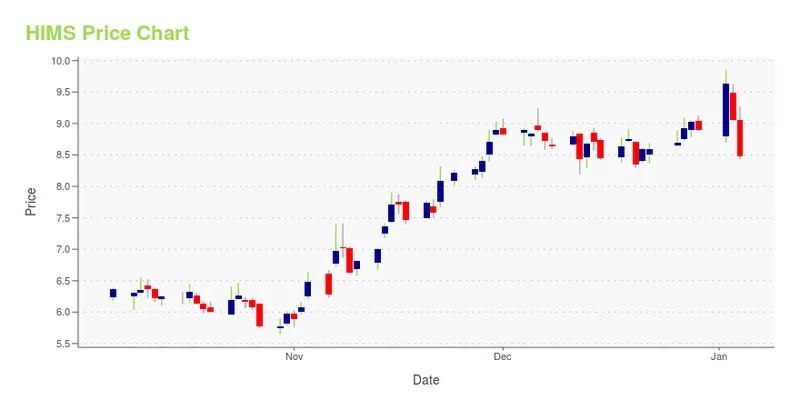Article Directory
When a company’s stock jumps 16% in a single day, while the rest of the market barely nudges, it’s not just noise. It’s a signal. You could almost feel the digital hum of Wall Street waking up to a reality that half the population has known for centuries. On Wednesday, Hims & Hers Health didn't just launch a new product line for menopause; they lit a beacon, signaling a profound shift in how we think about technology, health, and a massively underserved market.
What the traders and algorithms saw wasn't just a new revenue stream. They saw the application of a modern, data-driven, user-centric model to a problem the traditional healthcare system has largely ignored, or worse, treated as an unavoidable personal failing. For decades, navigating perimenopause and menopause has been like being handed a faded, one-size-fits-all road map from the 1970s, filled with vague warnings and few clear directions. You were told to just "deal with it."
This is different. This is the Waze for women's health.
Hims & Hers is building a platform—let's be clear, it's a technology platform first and a healthcare provider second—that offers personalized treatment plans based on an individual's specific health history. This uses a tech-first approach—in simpler terms, it means using the power of software, data, and accessibility to build a system around the user, not the other way around. It’s the difference between a static map and a dynamic, real-time GPS that reroutes you based on current conditions. The fact that only 30% of OB/GYN residency programs offer formal menopause training isn't just a statistic; it's a colossal system failure. A failure that technology is now perfectly poised to address.
When I first read about this launch, I honestly just sat back in my chair for a moment. This is the kind of breakthrough that reminds me why I got into this field in the first place. It’s not about the elegance of the code, but the elegance of the solution to a deeply human problem.
The Billion-Dollar Bet on Being Seen
The market’s enthusiastic reaction, sending 29 million shares flying in a day, wasn’t a gamble. It was a long-overdue acknowledgment of a simple, staggering truth: an addressable market of 1.3 million American women entering menopause each year has been left to fend for itself. Hims & Hers, a company on track to surpass a billion dollars in annual revenue, is simply pointing its already-proven telehealth engine at this gaping void.

This is where it gets truly exciting for me. The platform model isn't just about convenience or selling prescription creams online. It’s about creating a dynamic feedback loop between a patient and a provider powered by a platform that learns and adapts—it means the care you get on day 365 could be infinitely more tailored than the care you got on day one and that's a paradigm shift we've only dreamed of in mass-market healthcare. Imagine a system that can aggregate anonymized data to identify which treatments work best for which symptoms and for which demographic profiles, continuously refining its own intelligence.
Of course, with great data comes great responsibility. The trust required to hand over this kind of personal health information is immense, and the company’s biggest challenge will be to prove it is a worthy steward of that data. But if they get it right, the implications are staggering.
What other "invisible" health crises could this model address? What about chronic fatigue, endometriosis, or autoimmune disorders that disproportionately affect women and are often dismissed or misdiagnosed for years? Could this be the blueprint for a new era of proactive, personalized, and truly accessible healthcare?
From Taboo to Tech-Enabled
There’s a historical parallel here that I can’t shake. Think about the at-home pregnancy test. Before its invention, a woman’s own biological reality was something she had to have confirmed by a medical authority, often after weeks of uncertainty. The test didn't change the biology, but it fundamentally changed the dynamic. It moved a critical piece of information—and therefore, power—from the institution to the individual.
That’s what’s happening here, but on a much grander scale. This isn’t just about treating hot flashes. It’s about destigmatizing a natural life stage and empowering millions with information, access, and agency over their own bodies. Jessica Shepherd, the Chief Medical Officer of Hers, said it perfectly: "Women have been navigating an outdated healthcare system that wasn't designed for them for too long."
The system wasn't just outdated; it was built on a foundation of omission. It simply didn't see these issues as priorities. But when a company with over half a million subscribers and a billion-dollar revenue trajectory turns its focus to this problem, it forces the world to see it, too. The 16% stock surge wasn't just investors chasing a trend. It was the sound of a market finally pricing in the value of a population that has been invisible for far too long. And that sound is just the beginning.
A New Operating System for Health
Let's call this what it is. This isn't just another telehealth vertical. This is the beta test for a new operating system for personalized wellness. We've spent a decade optimizing supply chains, food delivery, and ride-sharing. Now, finally, that same relentless, user-focused technological energy is being aimed at the deeply personal, complex, and utterly vital systems of the human body. This is more than a business move; it's a fundamental upgrade to the human experience.
